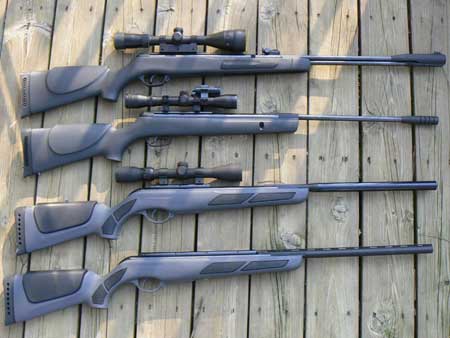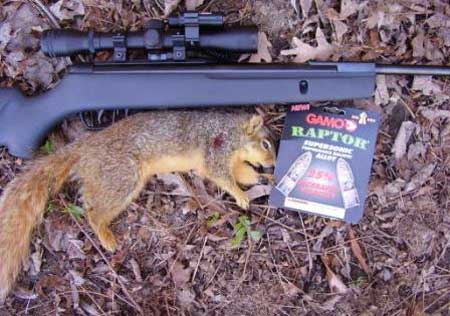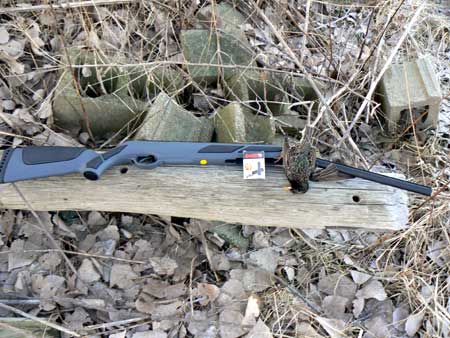Gamo Airguns Review
This is a Community Review of the Gamo air rifles. The author of the following review are in no way affiliated with Airgun Depot. The views expressed below are personal opinion only. This article reviews the following Gamo Air Rifles:  Gamo rifles (top to bottom): CFX, Varmint Hunter, Viper, and Viper express.
Gamo rifles (top to bottom): CFX, Varmint Hunter, Viper, and Viper express.Introduction
I have to admit, I live in a world of airgun snobs. This is a provocative statement, but I deal with people that are classic airgun aficionados, competitive shooters, serious collectors, and hunters that get a kick out of high end guns. They feel that if a gun doesn’t ding your wallet to the tune of several hundreds of dollars something must be wrong with it …. Or you for buying it! However, the largest producer of airguns in the world is Gamo, and they have made a business of high quality, mass produced, affordable spring piston airguns for just about any application or style of shooting. I consider them the “Ruger” of the airgun world as a matter of fact. You may give up some of the aesthetics found in much more expensive guns, but you don’t give up excellent performance in terms of accuracy or power. Sure, you won’t get one hole groups at 25 yards like you might with a well tuned top dollar gun, but the truth is not many people can shoot a springer well enough to wring this type of accuracy anyway. But if what you are looking for is a solid small game hunting rifle, a gun for pest control, or an all around fun plinker, Gamo offers a line that is at the top of my list. My forte is hunting, and I can be just as effective, and have just as much fun in the field with a quality mainstream product as I can with one of my $400 – $1000 tuned premium guns. Don’t get me wrong, I love a beautiful custom stocked, tuned to the nines work of airgun art as much (if not more) than the next guy. My point is that it’s not everyone’s priority to spend a months rent to shoot squirrels during the season or thin out the varmint around the barn… and you don’t need to. Gamo offers several rifles I like a lot, and a couple that I really love! Airgun Depot is a premier distributor for Gamo in the USA, and when asked to write a review of some of their guns I jumped at it. The guns I chose to cover in the article were; Varmint Hunter, CFX, Stutzen, Delta, and Viper Express. I felt these guns covered the range fairly well from low power (Delta) kids gun, to high power (Hunter) game getter, to the first spring piston air powered shotgun (Express). I have scores of airguns in my collection of every type, and while I borrowed a couple of the guns discussed, most are in my personal collection ….. I bought them, I shoot them, and I hunt with them.
Gamo Delta
(Now Discontinued, check out the Gamo Recon)  The Delta was capable of cleanly killing these three rabbits at 20 yards using head shots.
The Delta was capable of cleanly killing these three rabbits at 20 yards using head shots. The Delta (now discontinued) is the lowest powered and smallest of the Gamo spring piston air rifles with a weight of 4.2 lb, an overall length: 37.8" and an adjustable two stage trigger with a pull of 3.3 lb. The guns stock is a synthetic with a Monte Carlo cheekpiece, and the receiver is grooved to take a scope. The break barrel action has a very light (21 lb) cocking effort that a youngster could handle, which was perfect as my intention was to give this rifle to my nephew after my pest control outing. My nephew wanted to use this gun to hunt in the fields around his house, so I decided to take the gun out for a spin to see if it was up to the job before giving it to him. I arrived at one of my hunting spots very early one morning; it was about a half hour before daybreak. I spooked a couple bunnies as I got situated, but knew the rabbits were not too fidgety and would reappear throughout the day. I sat myself down beside an old live oak and waited. After about twenty minutes I saw three rabbits come out of the bushes 25 yards away, which I thought was probably a little bit too far. They slowly grazed and moved in my direction, but before they got inside of range, a couple more came out right in front of me. I lined up a head shot and rolled the rabbit closest to me, which caused the other rabbits to head back towards the brush. I cocked the rifle and rolled the second rabbit when he stopped momentarily, causing the rest to bolt. As the morning progressed I managed to bag three rabbits without too much effort using a rifle that produced 500 fps and change….. again driving home my much chanted mantra, it’s all about the accuracy! The gun had proved adequate to the task, the power was probably marginal, but at less than twenty yards it was possible to stack one pellet on top of another all day long. I think for a kid just getting started this would be a perfect rifle that is manageable, scaled to a smaller shooter, and capable of taking small game. My nephew loves this gun and has been shooting it for a couple years now.
 The Varmint Hunters and Raptor pellets made a good combination for squirrel, penetrating this bushytail side to side.
The Varmint Hunters and Raptor pellets made a good combination for squirrel, penetrating this bushytail side to side. The
Varmint hunter is based on the Gamo Shadow series of break barrel spring piston air rifle. The gun is dressed in a black synthetic stock, with a compliment of lights, lasers, and optics riding atop it. I have to admit, I’m a traditional kind of guy and have always preferred wood, however this rifles stock does give it a businesslike appearance. The stock is an all weather synthetic material with an ambidextrous cheekpeice that is designed to achieve good sight alignment when using a scope. The stock is equipped with a ventilated rubber butt pad, and the pistol grip and forestock are checkered. The result is an easy to shoulder gun that aims naturally and carries well. The varmint Hunter is cocked by breaking the barrel with a moderately heavy 38 lb cocking effort, but due to the long sweep of the cocking action seemed lighter to me. The gun is advertised to generate velocities of 1000 fps, which is pretty close to what I achieved with some projectiles. The 28” barrels precision rifling along with the two stage trigger (with first stage being adjustable), permitted excellent accuracy to be obtained. I had the gun set up with very little initial creep and a clean break at about 3.5 lb. The thing that makes the Varmint Hunter the Varmint Hunter is the accessories that are included in the package. The rifle has a grooved receiver that mounts a scope, onto which a flashlight and a laser are affixed. Both of these lighting systems are activated via a pressure sensitive switch and can be easily deployed from the typical shooters hand position on the forestock . To get a handle on how the gun performed, I shot several pellets across the chrony and then shot for groups at twenty five yards. Many brands of pellets yielded adequate accuracy for most hunting applications, and while I wasn’t surprised that the Gamo Hunters offered up tight groups, the fact that the
Raptors grouped so well wasn’t expected. In several guns I’d tested this pellet in; the accuracy past 15-20 yards was so-so at best. But with the Varmint Hunter I got consistently good results at 25 yards. I brought this gun along on a few pest control outings; to shoot sparrows and starlings around the feeders and outbuildings at a local farm, to try to get rid of some rats around the barn, and clear out a few squirrels that were getting into the rafters and crawl spaces of the farmhouse. I shot Gamo hunters when culling the bird pests and rats as I was concerned about over penetration, but on the squirrels I used the new
Raptor pellets as I was interested in seeing what kind of terminal performance could be achieved. This pellet/gun combination was very effective, and I found that a 25 yard broadside on a squirrel would at least end up coming to rest on the offside skin line if not outright penetrating the critter side to side. This gun combined the power and accuracy to make for an effective small game/pest control rig.

On one trip I carried the Viper Express for in close shooting and the CFX for long shots. One of the Gamo airguns that has received a lot of accolades lately, even with the hardcore airgunning community, is the
CFX. This rifle produces enough power for just about any small game quarry, but the real story is the outstanding accuracy delivered by this fixed barrel rifle. The CFX produces approximately 1000 fps velocity with an 11 grain .177 pellet. The CFX barrel is rifled steel that is 20 inches in length, with an overall length of 47.75 inches. The receiver is grooved for mounting an 11 mm scope, and comes equipped with a fiber optic sight. The CFX uses an under barrel cocking arm to charge the gun, after the rifle is cocked the rotary breech can be opened allowing a pellet to be place directly into the barrel. I have never used a gun with this type of loading port, and after becoming acclimated to it found that I like it better than the pop up port found on the Stutzen. The barrel stays at a fixed position when cocking with the cocking lever, and many argue that this results in a more accurate gun. The rifle comes dressed in a black, all-weather synthetic stock with a ventilated butt pad, ambidextrous twin-cheek pads, and non-slip checkering. The trigger is a two stage with an adjustable second stage, and can be set up to offer a fairly light pull with good tactile response. On the bench I found this gun to be a real performer; I mounted a Nikko Stirling 4-12x42 variable scope and zeroed in at 35 yards. After shooting several pellets to see what the gun preferred (Gamo Hunter gave best results) I took it to the range for a bench session. I like the way this gun shoots, and for a gun that puts out this much power find it easy to cock with little felt recoil. The CFX was capable of sub half inch groups with a number of different pellets. Using the 8.3 grain Gamo Hunter pellets, the gun generated about 990 fps translating into xxx fpe at the muzzle which is perfect for rabbit sized game out to 45 yards. I am very impressed by the accuracy of the CFX, taking it out on a recent pest bird shoot it seemed like I could not miss. Lining up shots between 30 – 50 yards, grackles and starlings were falling left and right. The power generated was more than enough to anchor them, and I have to say it is the best I’ve done with a springer in a long time, making 22 hits on 28 shots. I think the weight of the integrated muzzle break/front sight/ under barrel level cocking assembly helps to dampen the recoil, and found that it was possible to watch the pellet impact. While the Stutzen is probably my favorite Gamo rifle with all things considered (I have to admit I love the stock on this rifle more than anything else), the CFX has become my favorite based on the outstanding performance. This
Gamo CFX is a shooter, and I don’t think there are too many guns in my (extensive) collection of spring piston airguns that can outshoot this one.
Gamo Stutzen

The Stutzen is a beautiful gun that I love to carry and shoot in the field. I have always liked the look and feel of a Manlicher stock, probably a holdover from my days in Southern Europe where this configuration has been popular for many years. As a matter of fact, both my 30-06 and 250 Savage are fitted out with a stocks of this design. It is no surprise then, from the first moment I saw a spring piston air rifle in this configuration I wanted one, however for one reason or another it never seemed to float up as a priority when buying another airgun. But recently the timing felt right and I decided to finally pick one up for my collection ….. but which one? There are two or three on the market, but in the end I was attracted to the Gamo Stutzen for a couple of reasons; I’d been hearing good things about the Gamo line of fixed barrel rifles as hunting guns and wanted to give one a try. And most importantly, when I picked up this rifle I really liked the look and feel of it. In this short review I will discuss the guns features and bench performance, and then discuss my impressions based on taking it to the field to hunt squirrels, rabbits, and other small game. The Gamo Stutzen is a fixed barrel rifle which is cocked by an underlever cocking mechanism. The Manlicher design is a full length one piece stock that extends to just below the muzzle. I like the aesthetics of the Manlicher stock because of its unbroken lines, which is especially appealing in an air rifle as it makes it look more “firearm like”. The underlever action is the only one that lends itself to this design, as the cocking lever can be hidden within the recessed forearm of the Manlicher stock. The gun comes in .177 Caliber only, which is fine by me as this is my preference in a spring piston airgun. The guns overall length is 39.5 inches, with an 11 inch barrel. The specification states that the gun comes with a beech hardwood stock that weighs 6.4 lbs, mine is 7 lbs with the scope, which is surprising as the gun looks heavier due to the full length furniture. As mentioned the cocking mechanism uses an underlever arm which is housed in the recessed forestock. There is a tubular handle that slides out to increase the length of the cocking arm by about four inches, resulting in a cocking effort of 50 lb, which is easily handled by most adults. When the gun is cocked, a loading port situated between the piston chamber and the barrel pops up providing convenient access ….. a nice feature in a hunting rifle. The gun comes equipped with iron sights; the front sight is a post and the rear sight is adjustable for windage and elevation. I mount scopes on all my hunting rifles, and the Stutzen has an integrated dovetail and an elevated scope ramp. As mentioned, the stock is made of beech hardwood and has a raised Monte Carlo cheekpiece, with a laser carved checkering on the grip. This is a nice touch on a moderately priced gun The published velocity for the Stutzen is 950 fps, depending on pellets I obtained between 910 to 940 fps. Of the pellets tested, the one that yielded the best all around performance was the
RWS Superdome. It produced and average velocity of 915 fps, and an average 30 yard group size of under an inch at 30 yards. This is not stellar accuracy; however for a hunting gun it is just fine in my books. I figure that this will allow me to obtain consistent head shots on squirrels and rabbits, which is all I need to do. The Stutzen was fairly pellet tolerant and shot a range of projectiles quite well, the little pop up magazine able to handle the pronounced point of the Predator pellets without problem. Having established that the gun had the power and the accuracy on the bench, the next step was to take it hunting. I found the gun came naturally to the shoulder, and the comb was at the proper height to consistently offer a good sight alignment. The two stage trigger has a first stage adjustment, which was set at about 3.4 lb pull on my gun. There was no creep or over-travel and the trigger had a good tactile response overall. The scope mounted for my hunting forays was a compact Leapers Mini Mildot, which besides functioning quite well, looks just right on this gun. The pellets used for hunting included
RWS Superdomes and Predator Polymer Tips. Both are good hunting loads; the RWS were more accurate especially at longer range, but the Predators were reasonably accurate and had a tremendous downrange impact on quarry. I found that the gun performed very well in anchoring squirrels and rabbits when I did my job; the physical characteristics of the Stutzen and the inherent accuracy of the gun made it a solid choice as a small game gun. In the field I found it easy to shoot standing, sitting, prone, supported or offhand; some springers are difficult to shoot accurately when rested, but I did not encounter this problem with the Gamo Stutzen. In my experience cocking and loading the gun could be accomplished fairly quickly, though this is perhaps not the optimal gun to take along when hunting in deep camouflage. The cocking action is not difficult, but it is a big motion that is hard to minimize as you have to extend the cocking arm to permit full leveraging of the mechanism. The second minor complaint is that I have not yet figured out how to mount a sling, which I prefer on rifles intended for carry on long hikes. So what’s the bottom line? I like this gun a lot, to be honest as much (or maybe more) for it’s looks, but by any measure it is a quality, high performance air rifle. It is one that will stay in my collection and come out a few times a year for the pleasure of shooting at paper and game. I didn’t know what to expect from this gun; it is a paradox that Gamo is arguably the largest airgun manufacturer in the world, but does not enjoy a uniformly great reputation amongst hardcore airgunners. I think that there is a bit of snobbery in this, analogous to the coffee connoisseur that thumbs his nose at Starbucks refusing to acknowledge that millions upon millions find the product meets their needs very well. The Gamo Stutzen does meet my needs as a quality hunting rifle, one that I also like to handle and look at.

The Viper Express and the purpose designed shot shells are an absolute blast for fast and furious inside shooting. This is one of the most unique spring piston airguns to come along in recent years, and ever since hearing about it at the 2006 SHOT Show I have been waiting anxiously to get my hands on one. The
Viper Express is the first spring piston scatter gun to hit the market, utilizing a traditional break barrel action and a purpose designed shot shell. The shell is a plastic cylinder which has an inverted cap in the rear and a plastic tab in front that holds a 17 grain load of #9 shot in place. These
shells come packaged in a box containing
25 shells. These shells are not re-loadable as are the brass shells for the old CO2 scatterguns that were available in the past (though none have been manufactured in years). I was not so sure what to expect with the Viper Express, so started off shooting at a plain sheet of butcher’s paper to pattern the gun at 10 yards, I found that the scatter was confined within an area of 6” diameter. Several of the #9 pellets hit in an approximately starling sized area, and hit with enough umph to penetrate a coke can. I followed up this session by taking some balloons from my six year old daughter’s toy chest, blowing them up, and letting the gentle breeze drift them across the yard while I shot at them. I was having fun! OK, so I proved to myself that this gun was fun to play shooting games with, but I was curious about the manufacturers claim that this gun could be used for pest control at close range. There is a factory complex by my house that has overgrown fields juxtaposed with sheds and equipment scattered around it in jumbled heaps, the sparrow and starlings flock to the area in numbers. I decided this would be the perfect place to try some pest bird wing shooting. By the time I’d wrapped up my first field session I’d taken a half dozen sparrows and a couple starlings, even managing to hit a couple of them on the wing. The gun was effective on these light bodied critters, though I was pretty strict about keeping all shots inside of 10 yards. A couple of times I missed and hit the roof of a shed or the rain gutters around the wooden office building, without causing any damage. I think with a light attached this gun may be adequate for a night time ratting session at one of the local farms I shoot at. To date I’ve taken dozens of starlings, grackles, and blackbirds with this gun, and continue to be surprised at its efficacy. And a point of interest is that a lot of this shooting took place close in at a very fast pace, where there would not have been time to get a good sight through a scope or even over iron sights. This gun opened up new opportunities for shooting, which is one of the big attractions of airgun hunting in my view, allowing shooting in places that a firearm would be a no-go. So what do I think about the Viper Express? This is an ideal gun to shoot pest of slight stature, such as small rodents around the barn or starlings raiding the feeders. As a kicker, there is a barrel insert which allows the gun to shoot standard pellets when you get tired of using it as a scatter gun …….. if you get tired of it!
Summary
So what do I think about the Gamo rifles I’ve shot? If I am critical I’d have to say that the triggers are OK but not great. A serious field or target shooter might not be happy with the less than match level performance, but I think for most hunters and plinkers they are just fine. And if it is really an issue for you (it is not for me), there are after market triggers the hobbyist can drop in. Many of the guns use a lot of synthetics for stocks and I like wood better, but at least some of the models can be ordered with wood as an option. There are a lot of people, probably a vast majority, that want a quality rifle but don’t want to spend a fortune. I think the Gamo rifles described above are solid performers with good accuracy and a lot of power, some like the CFX can stand toe to toe with just about any gun at any price point ….. a perfect example of a lot of bang for the buck!





